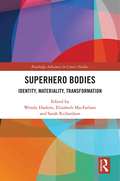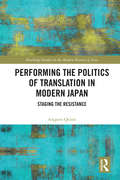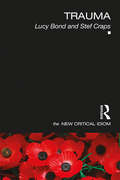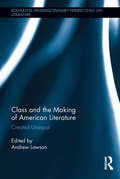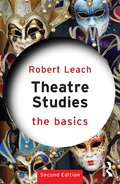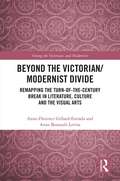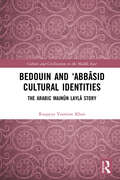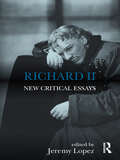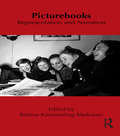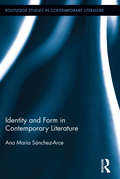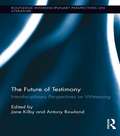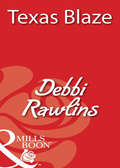- Table View
- List View
Shakespeare’s Things: Shakespearean Theatre and the Non-Human World in History, Theory, and Performance (Perspectives on the Non-Human in Literature and Culture)
by Brett Gamboa Lawrence SwitzkyFloating daggers, enchanted handkerchiefs, supernatural storms, and moving statues have tantalized Shakespeare’s readers and audiences for centuries. The essays in Shakespeare’s Things: Shakespearean Theatre and the Non-Human World in History, Theory, and Performance renew attention to non-human influence and agency in the plays, exploring how Shakespeare anticipates new materialist thought, thing theory, and object studies while presenting accounts of intention, action, and expression that we have not yet noticed or named. By focusing on the things that populate the plays—from commodities to props, corpses to relics—they find that canonical Shakespeare, inventor of the human, gives way to a lesser-known figure, a chronicler of the ceaseless collaboration among persons, language, the stage, the object world, audiences, the weather, the earth, and the heavens.
The Value of Time in Early Modern English Literature
by Tina SkouenThe stigma of haste pervaded early modern English culture, more so than the so-called stigma of print. The period’s writers were perpetually short on time, but what does it mean for authors to present themselves as hasty or slow, or to characterize others similarly? This book argues that such classifications were a way to define literary value. To be hasty was, in a sense, to be irresponsible, but, in another sense, it signaled a necessary practicality. Expressions of haste revealed a deep conflict between the ideal of slow writing in classical and humanist rhetoric and the sometimes grim reality of fast printing. Indeed, the history of print is a history of haste, which carries with it a particular set of modern anxieties that are difficult to understand in the absence of an interdisciplinary approach. Many previous studies have concentrated on the period’s competing definitions of time and on the obsession with how to use time well. Other studies have considered time as a notable literary theme. This book is the first to connect ideas of time to writerly haste in a richly interdisciplinary manner, drawing upon rhetorical theory, book history, poetics, religious studies and early modern moral philosophy, which, only when taken together, provide a genuinely deep understanding of why the stigma of haste so preoccupied the early modern mind. The Value of Time in Early Modern English Literature surveys the period from ca 1580 to ca 1730, with special emphasis on the seventeenth century. The material discussed is found in emblem books, devotional literature, philosophical works, and collections of poetry, drama and romance. Among classical sources, Horace and Quintilian are especially important. The main authors considered are: Robert Parsons; Edmund Bunny; King James 1; Henry Peacham; Thomas Nash; Robert Greene; Ben Jonson; Margaret Cavendish; John Dryden; Richard Baxter; Jonathan Swift; Alexander Pope. By studying these writers’ expressions of time and haste, we may gain a better understanding of how authorship was defined at a time when the book industry was gradually taking the place of classical rhetoric in regulating writers’ activities.
Superhero Bodies: Identity, Materiality, Transformation (Routledge Advances in Comics Studies)
by Wendy Haslem Elizabeth MacFarlane Sarah RichardsonThroughout the history of the genre, the superhero has been characterised primarily by physical transformation and physical difference. Superhero Bodies: Identity, Materiality, Transformation explores the transformation of the superhero body across multiple media forms including comics, film, television, literature and the graphic novel. How does the body of the hero offer new ways to imagine identities? How does it represent or subvert cultural ideals? How are ideologies of race, gender and disability signified or destabilised in the physicality of the superhero? How are superhero bodies drawn, written and filmed across diverse forms of media and across histories? This volume collects essays that attend to the physicality of superheroes: the transformative bodies of superheroes, the superhero’s position in urban and natural spaces, the dialectic between the superhero’s physical and metaphysical self, and the superhero body’s relationship with violence. This will be the first collection of scholarly research specifically dedicated to investigating the diversity of superhero bodies, their emergence, their powers, their secrets, their histories and their transformations.
Superhero Bodies: Identity, Materiality, Transformation (Routledge Advances in Comics Studies)
by Wendy Haslem Elizabeth MacFarlane Sarah RichardsonThroughout the history of the genre, the superhero has been characterised primarily by physical transformation and physical difference. Superhero Bodies: Identity, Materiality, Transformation explores the transformation of the superhero body across multiple media forms including comics, film, television, literature and the graphic novel. How does the body of the hero offer new ways to imagine identities? How does it represent or subvert cultural ideals? How are ideologies of race, gender and disability signified or destabilised in the physicality of the superhero? How are superhero bodies drawn, written and filmed across diverse forms of media and across histories? This volume collects essays that attend to the physicality of superheroes: the transformative bodies of superheroes, the superhero’s position in urban and natural spaces, the dialectic between the superhero’s physical and metaphysical self, and the superhero body’s relationship with violence. This will be the first collection of scholarly research specifically dedicated to investigating the diversity of superhero bodies, their emergence, their powers, their secrets, their histories and their transformations.
Performing the Politics of Translation in Modern Japan: Staging the Resistance (Routledge Studies in the Modern History of Asia)
by Aragorn QuinnPerforming the Politics of Translation in Modern Japan sheds new light on the adoption of concepts that motivated political theatres of resistance for nearly a century and even now underpin the collective understanding of the Japanese nation. Grounded in the aftermath of the Meiji Restoration in 1868 and analyzing its legacy on stage, this book tells the story of the crucial role that performance and specifically embodied memory played in the changing understanding of the imported Western concepts of "liberty" (jiyū) and "revolution" (kakumei). Tracing the role of the post-Restoration movement itself as an important touchstone for later performances, it examines two key moments of political crisis. The first of these is the Proletarian Theatre Movement of the 1920s and '30s, in which the post-Restoration years were important for theorizing the Japanese communist revolution. The second is in the postwar years when Rights Movement theatre and thought again featured as a vehicle for understanding the present through the past. As such, this book presents the translation of "liberty" and "revolution", not through a one-to-one correspondence model, but rather as a many-to-many relationship. In doing so, it presents a century of evolution in the dramaturgy of resistance in Japan. This book will be useful to students and scholars of Japanese history, society and culture, as well as literature and translation studies alike.
Trauma (The New Critical Idiom)
by Lucy Bond Stef CrapsTrauma has become a catchword of our time and a central category in contemporary theory and criticism. In this illuminating and accessible volume, Lucy Bond and Stef Craps: provide an account of the history of the concept of trauma from the late nineteenth century to the present day examine debates around the term in their historical and cultural contexts trace the origins and growth of literary trauma theory introduce the reader to key thinkers in the field explore important issues and tensions in the study of trauma as a cultural phenomenon outline and assess recent critiques and revisions of cultural trauma research Trauma is an essential guide to a rich and vibrant area of literary and cultural inquiry.
Class and the Making of American Literature: Created Unequal (Routledge Interdisciplinary Perspectives on Literature)
by Andrew LawsonThis book refocuses current understandings of American Literature from the revolutionary period to the present-day through an analytical accounting of class, reestablishing a foundation for discussions of class in American culture. American Studies scholars have explored the ways in which American society operates through inequality and modes of social control, focusing primarily on issues of status group identities involving race/ethnicity, gender, sexuality, and disability. The essays in this volume focus on both the historically changing experience of class and its continuing hold on American life. The collection visits popular as well as canonical literature, recognizing that class is constructed in and mediated by the affective and the sensational. It analyzes class division, class difference, and class identity in American culture, enabling readers to grasp why class matters, as well as the economic, social, and political matter of class. Redefining the field of American literary cultural studies and asking it to rethink its preoccupation with race and gender as primary determinants of identity, contributors explore the disciplining of the laboring body and of the emotions, the political role of the novel in contesting the limits of class power and authority, and the role of the modern consumer culture in both blurring and sharpening class divisions.
Theatre Studies: The Basics (The Basics)
by Robert LeachNow in a second edition, Theatre Studies: The Basics is a fully updated guide to the wonderful world of theatre. The practical and theoretical dimensions of theatre – from acting to audience – are woven together throughout to provide an integrated introduction to the study of drama, theatre and performance. Topics covered include: dramatic genres, from tragedy to political documentary theories of performance the history of the theatre in the West acting, directing and scenography With a glossary, chapter summaries and suggestions for further reading throughout, Theatre Studies: the Basics remains the ideal starting point for anyone new to the subject.
Beyond the Victorian/ Modernist Divide: Remapping the Turn-of-the-Century Break in Literature, Culture and the Visual Arts (Among the Victorians and Modernists)
by Anne-Florence Gillard-Estrada Anne Besnault-LevitaBeyond the Victorian/ Modernist Divide contributes to a new phase in the Victorian-modern debate of traditional periodization through the perspective lens of literature and the visual arts. Breaking away from conventionally fixed discourses and dichotomies, this book utilizes an interdisciplinary approach to examine the existence of overlaps and unexplored continuities between the Victorians, the post-Victorians and the modernists, including the fields of music, architecture, design, science, and social life. Furthermore, the book remaps the cultural history of two critical meta-narratives and their interdependence – the myth of "high modernism" and the myth of "Victorianism" – by building on recent scholarly work and addressing the question of the "turn of the century break theory" with a new set of arguments and contributions. The essays presented within acknowledge the existence of a break-theory in modernism, but question this theory by re-contextualising it while uncovering long-masked continuities between artists, genres and forms across the divide. The collection offers a new approach to modernism, Edwardianism, and Victorianism; utilizing the cross-fertilisation of interdisciplinary approaches, and by combining contributions that look forward from the Victorians with other contributions that look backward from the modernists. While literary modernism and its vexed relationships with the nineteenth century is a central subject of the book, further analysis includes artistic discourses and theories stemming from history, the visual arts, science, music and design. Each chapter offers a fresh interpretation of individual artists, navigating away from characteristic classifications of works, authors and cultural phenomena. Ultimately, the volume argues that though periodization and genre categories play substantial roles in this divide, it is also essential to be critically aware of the way cultural history has been, and continues to be, constructed.
Bedouin and ‘Abbāsid Cultural Identities: The Arabic Majnūn Laylā Story (Culture and Civilization in the Middle East)
by Ruqayya Yasmine KhanThis literary-historical book draws out and sheds light upon the mechanisms of "the ideological work" that the Arabic Majnūn Laylā story performed for ‘Abbāsid urbanite, imperial audiences in the wake of the disappearance of the "Bedouin cosmos." The study focuses upon the processes of primitivizing Majnūn in the romance of Majnūn Laylā as part of the paradigm shift that occurred in the ‘Abbāsid empire after the Greco-Arabian intellectual revolution. Moreover, this book demonstrates how gender and sexuality are employed in the processes of primitivizing Majnūn. As markers of "strangeness" and "foreignness" in the ‘Abbāsid interrogations of the multiple categories of ethnicity, culture, identity, religion and language present in their cosmopolitan milieus. Such "cultural work" is performed through the ideological uses of alterity given its mechanisms of distancing (e.g., temporal and spatial) and nearness (e.g., affective). Lastly, the Majnūn Laylā love story demonstrates, in its text and reception, that a Greco-Arabian and Greco-Persian subculture thrived in the centers of ‘Abbāsid Baghdad that molded and shaped the ways in which this love story was compiled, received and performed. Offering a corrective to the prevailing views expressed in Western scholarly writings on the Greco-Arabian encounter, this book is a major contribution to scholars and students interested in Islamic studies, Arabic and comparative literature, Middle East and gender studies.
Reexamining World Literature: Challenging Current Assumptions and Envisioning Possibilities
by Richard SerranoSerrano calls for a reassessment of the practice of World Literature with six case studies taken from the Arabic, Chinese, French, German, Korean and Latin American traditions. Although in recent years the field has adopted more inclusive and wide-ranging criteria for college-level anthologies of World Literature, and has seen the collection and publication of critical readers, book-length introductions, and even a history, the theoretical predisposition of most of its practitioners paradoxically has led to a shrinking of its horizons and a narrowing of its vision. Reexamining World Literature asks scholars to look beyond the current dominant definition of World Literature (works in English with broad reach or works in other languages with significant circulation in English translation) in order to engage with a range of complex texts that elude the field’s assumptions. World Literature need not be a we-are-the-world of shared values, but instead should ask readers to question what those values are.
Richard II: New Critical Essays (Shakespeare Criticism)
by Jeremy LopezArguably the first play in a Shakespearean tetralogy, Richard II is a unique and compelling political drama whose themes still resonate today. It is one of the few Shakespeare plays written entirely in verse and its format presents unique theatrical challenges. Politically engaged and controversial, it raises crucial debates about the relationship between early modern art, audience response and state power. This collection provides a comprehensive and up-to-date survey of the critical and theatrical history of the play. The substantial introduction surveys the history of critical interpretations of Richard II since the eighteenth century. The eleven newly written critical essays by leading and emerging scholars in the field then adopt an eclectic range of critical approaches that encourage scholars and students to pursue new and imaginative directions with the text.
Picturebooks: Representation and Narration (Children's Literature and Culture)
by Bettina Kümmerling-MeibauerThis volume discusses the aesthetic and cognitive challenges of modern picturebooks from different countries, such as Denmark, France, Germany, Norway, Spain, Sweden, United Kingdom, and USA. The overarching issue concerns the mutual relationship between representation and narration by means of the picturebooks’ multimodal character. Moreover, this volume includes the main lines of debate and approaches to picturebooks by international leading researchers in the field. Topics covered are the impact of paratexts and interpictorial allusions, the relationship between artists’ books, crossover picturebooks, and picturebooks for adults, the narrative defiance of wordless picturebooks, the representation of emotions in images and text, and the depiction of hybrid characters in picturebooks. The enlargement of the picturebook corpus beyond an Anglo-American picturebook canon opens up new horizons and highlights the diverging styles and genre shifts in modern picturebooks. This tendency also demonstrates the influence of specific authors and illustrators on the appreciation of the picturebook genre, as in the case of Astrid Lindgren’s picturebooks and the picturebooks created by renowned illustrators, such as Anthony Browne, Wolf Erlbruch, Stian Hole, and Bruno Munari. This book will be the definite contribution to contemporary picturebook research for many years to come.
Theatre Studies: The Basics (The Basics)
by Robert LeachNow in a second edition, Theatre Studies: The Basics is a fully updated guide to the wonderful world of theatre. The practical and theoretical dimensions of theatre – from acting to audience – are woven together throughout to provide an integrated introduction to the study of drama, theatre and performance. Topics covered include: dramatic genres, from tragedy to political documentary theories of performance the history of the theatre in the West acting, directing and scenography With a glossary, chapter summaries and suggestions for further reading throughout, Theatre Studies: the Basics remains the ideal starting point for anyone new to the subject.
Richard II: New Critical Essays (Shakespeare Criticism)
by Jeremy LopezArguably the first play in a Shakespearean tetralogy, Richard II is a unique and compelling political drama whose themes still resonate today. It is one of the few Shakespeare plays written entirely in verse and its format presents unique theatrical challenges. Politically engaged and controversial, it raises crucial debates about the relationship between early modern art, audience response and state power. This collection provides a comprehensive and up-to-date survey of the critical and theatrical history of the play. The substantial introduction surveys the history of critical interpretations of Richard II since the eighteenth century. The eleven newly written critical essays by leading and emerging scholars in the field then adopt an eclectic range of critical approaches that encourage scholars and students to pursue new and imaginative directions with the text.
Shakespeare’s Things: Shakespearean Theatre and the Non-Human World in History, Theory, and Performance (Perspectives on the Non-Human in Literature and Culture)
by Brett Gamboa Lawrence SwitzkyFloating daggers, enchanted handkerchiefs, supernatural storms, and moving statues have tantalized Shakespeare’s readers and audiences for centuries. The essays in Shakespeare’s Things: Shakespearean Theatre and the Non-Human World in History, Theory, and Performance renew attention to non-human influence and agency in the plays, exploring how Shakespeare anticipates new materialist thought, thing theory, and object studies while presenting accounts of intention, action, and expression that we have not yet noticed or named. By focusing on the things that populate the plays—from commodities to props, corpses to relics—they find that canonical Shakespeare, inventor of the human, gives way to a lesser-known figure, a chronicler of the ceaseless collaboration among persons, language, the stage, the object world, audiences, the weather, the earth, and the heavens.
Trauma (The New Critical Idiom)
by Lucy Bond Stef CrapsTrauma has become a catchword of our time and a central category in contemporary theory and criticism. In this illuminating and accessible volume, Lucy Bond and Stef Craps: provide an account of the history of the concept of trauma from the late nineteenth century to the present day examine debates around the term in their historical and cultural contexts trace the origins and growth of literary trauma theory introduce the reader to key thinkers in the field explore important issues and tensions in the study of trauma as a cultural phenomenon outline and assess recent critiques and revisions of cultural trauma research Trauma is an essential guide to a rich and vibrant area of literary and cultural inquiry.
Identity and Form in Contemporary Literature (Routledge Studies in Contemporary Literature)
by Ana María Sánchez-ArceThis ambitious and wide-ranging essay collection analyses how identity and form intersect in twentieth- and twenty-first century literature. It revises and deconstructs the binary oppositions identity-form, content-form and body-mind through discussions of the role of the author in the interpretation of literary texts, the ways in which writers bypass or embrace identity politics and the function of identity and the body in form. Essays tackle these issues from a number of positions, including identity categories such as (dis)ability, gender, race and sexuality, as well as questioning these categories themselves. Essayists look at both identity as form and form as identity. Although identity and form are both staples of current research on contemporary literature, they rarely meet in the way this collection allows. Authors studied include Beryl Bainbridge, Samuel Beckett, John Berryman, Brigid Brophy, Angela Carter, J.M. Coetzee, Anne Enright, William Faulkner, Mark Haddon, Ted Hughes, Kazuo Ishiguro, B.S. Johnson, A.L. Kennedy, Toby Litt, Hilary Mantel, Andrea Levy, Robert Lowell, Ian McEwan, Flannery O’Connor, Alice Oswald, Sylvia Plath, Jeremy Reed, Anne Sexton, Edith Sitwell, Wallace Stevens, Jeremy Reed, Jeanette Winterson and Virginia Woolf. The book engages with key theoretical approaches to twentieth- and twenty-first century literature of the last twenty years while at the same time advancing new frameworks that enable readers to reconsider the identity and form conundrum. In both its choice of texts and diverse approaches, it will be of interest to those working on English and American Literatures, gender studies, queer studies, disability studies, postcolonial literature, and literature and philosophy.
Bedouin and ‘Abbāsid Cultural Identities: The Arabic Majnūn Laylā Story (Culture and Civilization in the Middle East)
by Ruqayya Yasmine KhanThis literary-historical book draws out and sheds light upon the mechanisms of "the ideological work" that the Arabic Majnūn Laylā story performed for ‘Abbāsid urbanite, imperial audiences in the wake of the disappearance of the "Bedouin cosmos." The study focuses upon the processes of primitivizing Majnūn in the romance of Majnūn Laylā as part of the paradigm shift that occurred in the ‘Abbāsid empire after the Greco-Arabian intellectual revolution. Moreover, this book demonstrates how gender and sexuality are employed in the processes of primitivizing Majnūn. As markers of "strangeness" and "foreignness" in the ‘Abbāsid interrogations of the multiple categories of ethnicity, culture, identity, religion and language present in their cosmopolitan milieus. Such "cultural work" is performed through the ideological uses of alterity given its mechanisms of distancing (e.g., temporal and spatial) and nearness (e.g., affective). Lastly, the Majnūn Laylā love story demonstrates, in its text and reception, that a Greco-Arabian and Greco-Persian subculture thrived in the centers of ‘Abbāsid Baghdad that molded and shaped the ways in which this love story was compiled, received and performed. Offering a corrective to the prevailing views expressed in Western scholarly writings on the Greco-Arabian encounter, this book is a major contribution to scholars and students interested in Islamic studies, Arabic and comparative literature, Middle East and gender studies.
Identity and Form in Contemporary Literature (Routledge Studies in Contemporary Literature)
by Ana María Sánchez-ArceThis ambitious and wide-ranging essay collection analyses how identity and form intersect in twentieth- and twenty-first century literature. It revises and deconstructs the binary oppositions identity-form, content-form and body-mind through discussions of the role of the author in the interpretation of literary texts, the ways in which writers bypass or embrace identity politics and the function of identity and the body in form. Essays tackle these issues from a number of positions, including identity categories such as (dis)ability, gender, race and sexuality, as well as questioning these categories themselves. Essayists look at both identity as form and form as identity. Although identity and form are both staples of current research on contemporary literature, they rarely meet in the way this collection allows. Authors studied include Beryl Bainbridge, Samuel Beckett, John Berryman, Brigid Brophy, Angela Carter, J.M. Coetzee, Anne Enright, William Faulkner, Mark Haddon, Ted Hughes, Kazuo Ishiguro, B.S. Johnson, A.L. Kennedy, Toby Litt, Hilary Mantel, Andrea Levy, Robert Lowell, Ian McEwan, Flannery O’Connor, Alice Oswald, Sylvia Plath, Jeremy Reed, Anne Sexton, Edith Sitwell, Wallace Stevens, Jeremy Reed, Jeanette Winterson and Virginia Woolf. The book engages with key theoretical approaches to twentieth- and twenty-first century literature of the last twenty years while at the same time advancing new frameworks that enable readers to reconsider the identity and form conundrum. In both its choice of texts and diverse approaches, it will be of interest to those working on English and American Literatures, gender studies, queer studies, disability studies, postcolonial literature, and literature and philosophy.
The Future of Testimony: Interdisciplinary Perspectives on Witnessing (Routledge Interdisciplinary Perspectives on Literature)
by Antony Rowland Jane KilbyCelebrating the twentieth anniversary of the groundbreaking Testimony, this collection brings together the leading academics from a range of scholarly fields to explore the meaning, use, and value of testimony in law and politics, its relationship to other forms of writing like literature and poetry, and its place in society. It visits testimony in relation to a range of critical developments, including the rise of Truth Commissions and the explosion and radical extension of human rights discourse; renewed cultural interest in perpetrators of violence alongside the phenomenal commercial success of victim testimony (in the form of misery memoirs); and the emergence of disciplinary interest in genocide, terror, and other violent atrocities. These issues are necessarily inflected by the question of witnessing violence, pain, and suffering at both the local and global level, across cultures, and in postcolonial contexts. At the volume’s core is an interdisciplinary concern over the current and future nature of witnessing as it plays out through a ‘new’ Europe, post-9/11 US, war-torn Africa, and in countless refugee and detention centers, and as it is worked out by lawyers, journalists, medics, and novelists. The collection draws together an international range of case-studies, including discussion of the former Yugoslavia, Gaza, and Rwanda, and encompasses a cross-disciplinary set of texts, novels, plays, testimonial writing, and hybrid testimonies. The volume situates itself at the cutting-edge of debate and as such brings together the leading thinkers in the field, requiring that each address the future, anticipating and setting the future terms of debate on the importance of testimony.
Then the Fish Swallowed Him: A Novel
by Amir Ahmadi ArianA powerful and harrowing psychological portrayal of an individual struggle against the state written in the tradition of The Stranger and 1984, Then the Fish Swallowed Him is an urgent expose of how power can bend reality and the people forced to live within its parameters.
Stripped (Mills And Boon Blaze Ser.)
by Julie LetoSassy heroines and irresistible heroes embark on sizzling sexual adventures as they play the game of modern love and lust. Expect fast paced reads with plenty of steamy encounters. The power of lust!
At Her Beck and Call (Mills And Boon Blaze Ser. #Vol. 306)
by Dawn AtkinsFormer stripper Autumn Beshkin is an urban girl eyeing a new profession.
Texas Blaze: Captivate Me Texas Outlaws: Cole Alone With You Unexpected Temptation (Mills And Boon Blaze Ser. #509)
by Debbi RawlinsKate Manning's "blast from the past" has blown back to her quiet west Texas town!


